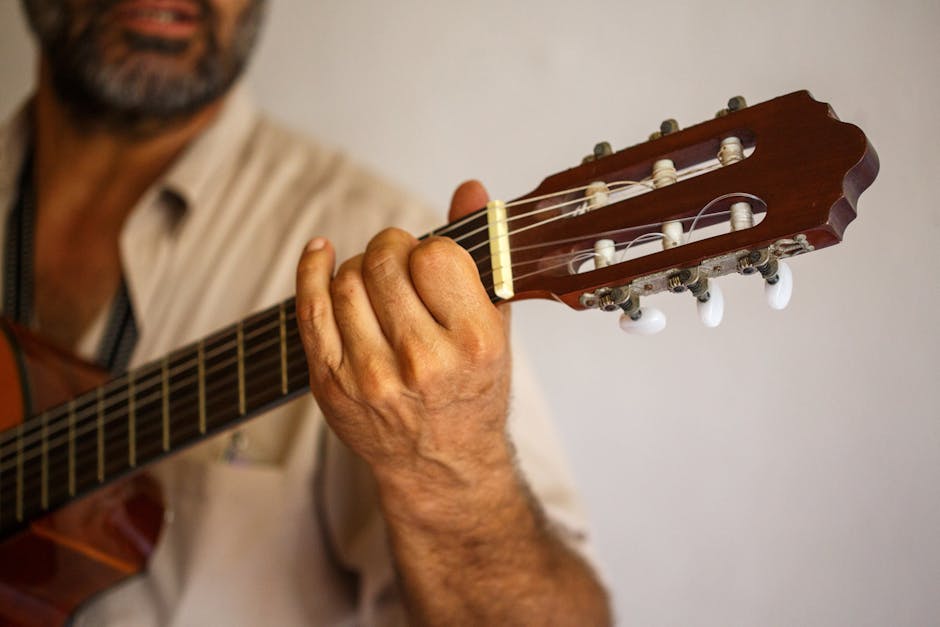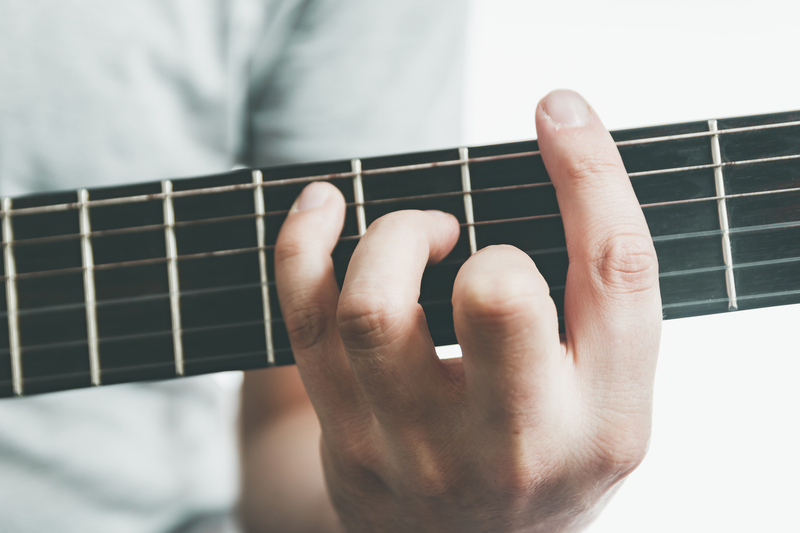So you’ve picked up a guitar and are ready to serenade the masses with your beginner skills? Well, fear not, because we’ve got just the thing to help you navigate the treacherous waters of chord progression. Say hello to our essential free guitar chord charts for novice musicians - your trusty sidekick in this wild musical adventure. Get ready to strum, pluck, and rock your way to guitar greatness!
Contents
- 1 Understanding the Basics of Guitar Chords
- 2 The Major Chords Every Guitarist Should Know
- 3 Navigating Through Minor Chords for a Diverse Repertoire
- 4 Mastering the Art of Transitioning Between Chords
- 5 Expanding Your Musical Horizon with Seventh Chords
- 6 Decoding Chord Symbols and Notations with Ease
- 7 Leveraging Chord Charts to Enhance Practice Sessions
- 8 FAQs
- 9 Go Strum Away!
Understanding the Basics of Guitar Chords
So you’ve picked up a guitar and you’re ready to rock out like a true legend. But before you can shred like Slash or jam like Jimi, you need to understand the basics of guitar chords.
First things first, let’s talk about the building blocks of chords – the notes. A chord is made up of three or more notes played simultaneously. These notes come from the major scale and are arranged in a specific pattern to create different chords. Don’t worry, you don’t need a degree in music theory to figure this out – just a dash of curiosity and a sprinkle of determination.
Next up, let’s chat about the different types of chords you’ll encounter. There are major chords, minor chords, and everything in between. Major chords have a happy, upbeat sound while minor chords have a more melancholy vibe. Pro tip: If you’re feeling emo, throw in a minor chord or two to really enhance those brooding feelings.
Now, it’s time to get your fingers moving. To play a chord on the guitar, you’ll need to position your fingers on the frets and strum the strings. Each fret represents a different note and when you combine them all together, you create the magical sound of a chord. It may feel like you’re doing finger gymnastics at first, but with practice, you’ll soon be flipping those chords like a pro.
The Major Chords Every Guitarist Should Know
So, you want to wow the crowd with your guitar skills, huh? Well, you better start mastering those major chords! Here are the essential major chords that every guitarist should know:
- A Major – This bad boy will have you feeling like a rockstar in no time. Just press down on the second fret of the D, G, and B strings, and strum away!
- C Major – Ah, the classic C major chord. It’s like a warm hug from your guitar. Place your fingers on the first fret of the B string and the second fret of the D and A strings, and you’ll be playing like a pro.
- G Major – This chord is the life of the party. Stick your fingers on the second fret of the A string, third fret of the low E string, and third fret of the high E string, and watch the crowd go wild.
These major chords are the building blocks of your guitar playing journey. Master them, and you’ll be well on your way to becoming a guitar god. Remember, practice makes perfect, so keep strumming and shredding those chords until your fingers can do it in their sleep. Rock on, fellow guitarist!

So you’ve mastered the major chords and now you’re ready to tackle the murky waters of minor chords. Don’t worry, we’ve got you covered with some tips and tricks to help you navigate through these moody little beasts.
First things first, let’s talk about the different types of minor chords. There’s the natural minor, the harmonic minor, and the melodic minor. Each one has its own unique sound and flavor, so it’s important to familiarize yourself with all three.
One way to remember the difference between the natural, harmonic, and melodic minor chords is to think of them as characters in a play. The natural minor is the brooding anti-hero, the harmonic minor is the mysterious villain, and the melodic minor is the eccentric sidekick. By associating each type of minor chord with a character, you can easily recall their distinct characteristics.
When incorporating minor chords into your repertoire, don’t be afraid to experiment and get creative. Mix them with major chords, try different inversions, or even throw in a few passing tones for added spice. The key is to have fun and let your imagination run wild. Who knows, you might just stumble upon a new and exciting sound that sets your playing apart from the rest.

Mastering the Art of Transitioning Between Chords
Transitioning between chords is like trying to smoothly switch lanes in heavy traffic – it requires finesse, timing, and a little bit of luck. But fear not, fellow guitarists, for with practice and determination, you too can master the art of seamless chord changes.
Here are some tips to help you navigate the treacherous waters of chord transitions:
- Finger positioning: Make sure your fingers are positioned correctly on the fretboard before you attempt to switch chords. This will help you avoid any awkward hand contortions mid-song.
- Practice makes perfect: Spend time practicing transitioning between chords slowly at first, and gradually increase your speed as you improve. Remember, Rome wasn’t built in a day — neither will your chord-changing prowess.
- Use a metronome: Keep a steady beat with a metronome to help you stay in rhythm while changing chords. This will also help you develop muscle memory for smoother transitions.
Remember, transitioning between chords is a skill that takes time to master. Don’t get discouraged if you fumble a few times – even the pros had to start somewhere. So keep practicing, keep strumming, and before you know it, you’ll be switching chords like a rock star.

Expanding Your Musical Horizon with Seventh Chords
So you’ve mastered your basic triads and you’re looking to take your musical journey to the next level? Look no further than seventh chords!
Seventh chords add an extra layer of complexity and richness to your music, giving it that extra “oomph” that will make your audience sit up and take notice. Not to mention, they sound pretty darn cool.
There are four main types of seventh chords to explore:
- Dominant seventh
- Major seventh
- Minor seventh
- Half-diminished seventh
Experimenting with these different types of seventh chords will open up a whole new world of musical possibilities for you. You’ll be writing jazz standards and R&B ballads in no time!
Decoding Chord Symbols and Notations with Ease
So you’ve been staring at that sheet music for hours, trying to figure out what all those cryptic symbols mean? Well, fear not, my fellow music enthusiast! I’m here to help you decode those pesky chord symbols and notations with ease.
Let’s start with the basics. Chord symbols are like a secret code that musicians use to communicate which chords to play. They can look pretty intimidating at first, but once you crack the code, you’ll wonder why you ever felt confused in the first place.
**Here are a few tips to help you demystify those chord symbols:**
- Remember that each letter represents a different note in the chord. For example, C means play a C major chord, Dm means play a D minor chord, and so on.
- Pay attention to any additional symbols or numbers that come after the chord letters. These can indicate things like the chord inversion, added notes, or even the tempo.
**And now, for some extra fun, let’s learn how to read those fancy notations:**
- Those squiggly lines? That’s a trill. It’s fancy, it’s fun, and it’s a great way to show off your musical prowess.
- Ever seen a “pp” or “ff” in your sheet music? That’s just shorthand for “pianissimo” (very soft) and “fortissimo” (very loud). So go ahead, play with emotion!
Leveraging Chord Charts to Enhance Practice Sessions
So you’re tired of playing the same old songs in your practice sessions, huh? Well, have no fear because chord charts are here to save the day! These magical sheets of music notation can take your practice sessions from drab to fab in no time.
With chord charts, you can easily switch up your repertoire and learn new songs without breaking a sweat. No more struggling to memorize complicated chord progressions or lyrics – just pull up a chord chart and you’re good to go!
And the best part? Chord charts are like a cheat code for musicians. They give you all the information you need in a simple, easy-to-read format, so you can spend less time deciphering music and more time actually playing it.
So next time you’re feeling stuck in a practice rut, give chord charts a try. You’ll be amazed at how much they can enhance your practice sessions and take your playing to the next level. Trust me, you won’t regret it!
FAQs
What are the most common guitar chords that novice musicians should learn?
Oh, the classics! You should definitely start with the basic open chords like A, C, D, E, G, and even the dreaded F chord. Once you’ve mastered those, you can move on to barre chords and power chords. Keep practicing, and you’ll be shredding in no time!
Are there any tricks for memorizing guitar chords?
Ah, the age-old struggle of trying to remember all those pesky chord shapes. One trick is to practice transitioning between chords in different songs. Another tip is to visualize the chord shapes in your mind when you’re not even playing. And of course, practice, practice, practice!
Where can I find free guitar chord charts online?
Oh, my dear novice musician, the internet is a treasure trove of free guitar chord charts! You can find them on sites like Ultimate Guitar, Chordie, and even good ol’ Google Images. Just type in the chord you want to learn, and voila, a world of possibilities at your fingertips!
How can I use guitar chord charts to improve my playing?
Well, first and foremost, make sure you’re looking at the correct chord chart for the song you’re playing. It’s also helpful to practice strumming along with the chord changes to really get the feel of the song. And don’t forget, practice makes perfect, so keep at it!
Go Strum Away!
So there you have it, a treasure trove of free guitar chord charts to kickstart your musical journey. Remember, practice makes perfect, so don’t be disheartened if you don’t get it right on the first try. Keep strumming, keep learning, and most importantly, keep having fun! Who knows, maybe one day you’ll be headlining your own concert with these essential chords under your belt. Happy strumming, novice musicians!



